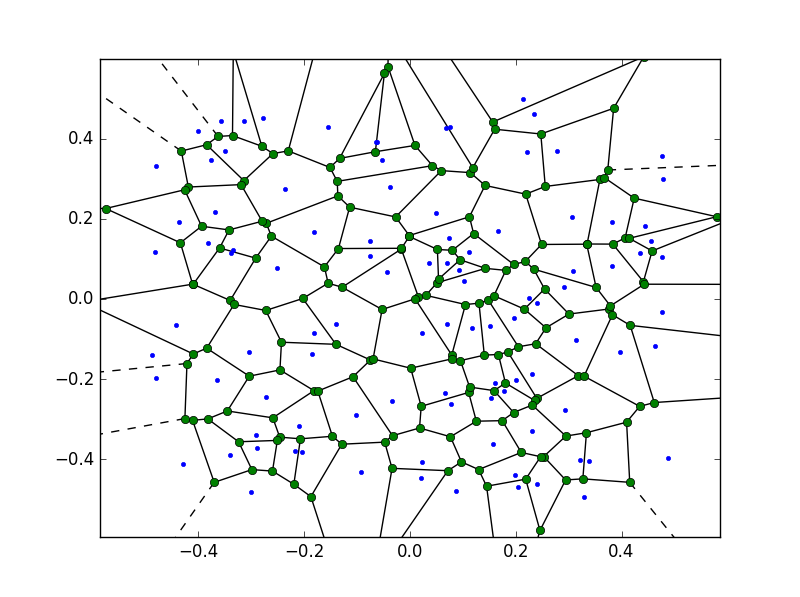It can be easyly be done with Shapely. You can install it from Conda Forge: conda install shapely -c conda-forge
Code you need at github.gist, based on answer by @Gabriel and @pv.:
# coding=utf-8
import numpy as np
import matplotlib.pyplot as plt
from scipy.spatial import Voronoi
from shapely.geometry import Polygon
def voronoi_finite_polygons_2d(vor, radius=None):
"""
Reconstruct infinite voronoi regions in a 2D diagram to finite
regions.
Parameters
----------
vor : Voronoi
Input diagram
radius : float, optional
Distance to 'points at infinity'.
Returns
-------
regions : list of tuples
Indices of vertices in each revised Voronoi regions.
vertices : list of tuples
Coordinates for revised Voronoi vertices. Same as coordinates
of input vertices, with 'points at infinity' appended to the
end.
"""
if vor.points.shape[1] != 2:
raise ValueError("Requires 2D input")
new_regions = []
new_vertices = vor.vertices.tolist()
center = vor.points.mean(axis=0)
if radius is None:
radius = vor.points.ptp().max()*2
# Construct a map containing all ridges for a given point
all_ridges = {}
for (p1, p2), (v1, v2) in zip(vor.ridge_points, vor.ridge_vertices):
all_ridges.setdefault(p1, []).append((p2, v1, v2))
all_ridges.setdefault(p2, []).append((p1, v1, v2))
# Reconstruct infinite regions
for p1, region in enumerate(vor.point_region):
vertices = vor.regions[region]
if all(v >= 0 for v in vertices):
# finite region
new_regions.append(vertices)
continue
# reconstruct a non-finite region
ridges = all_ridges[p1]
new_region = [v for v in vertices if v >= 0]
for p2, v1, v2 in ridges:
if v2 < 0:
v1, v2 = v2, v1
if v1 >= 0:
# finite ridge: already in the region
continue
# Compute the missing endpoint of an infinite ridge
t = vor.points[p2] - vor.points[p1] # tangent
t /= np.linalg.norm(t)
n = np.array([-t[1], t[0]]) # normal
midpoint = vor.points[[p1, p2]].mean(axis=0)
direction = np.sign(np.dot(midpoint - center, n)) * n
far_point = vor.vertices[v2] + direction * radius
new_region.append(len(new_vertices))
new_vertices.append(far_point.tolist())
# sort region counterclockwise
vs = np.asarray([new_vertices[v] for v in new_region])
c = vs.mean(axis=0)
angles = np.arctan2(vs[:,1] - c[1], vs[:,0] - c[0])
new_region = np.array(new_region)[np.argsort(angles)]
# finish
new_regions.append(new_region.tolist())
return new_regions, np.asarray(new_vertices)
# make up data points
np.random.seed(1234)
points = np.random.rand(15, 2)
# compute Voronoi tesselation
vor = Voronoi(points)
# plot
regions, vertices = voronoi_finite_polygons_2d(vor)
min_x = vor.min_bound[0] - 0.1
max_x = vor.max_bound[0] + 0.1
min_y = vor.min_bound[1] - 0.1
max_y = vor.max_bound[1] + 0.1
mins = np.tile((min_x, min_y), (vertices.shape[0], 1))
bounded_vertices = np.max((vertices, mins), axis=0)
maxs = np.tile((max_x, max_y), (vertices.shape[0], 1))
bounded_vertices = np.min((bounded_vertices, maxs), axis=0)
box = Polygon([[min_x, min_y], [min_x, max_y], [max_x, max_y], [max_x, min_y]])
# colorize
for region in regions:
polygon = vertices[region]
# Clipping polygon
poly = Polygon(polygon)
poly = poly.intersection(box)
polygon = [p for p in poly.exterior.coords]
plt.fill(*zip(*polygon), alpha=0.4)
plt.plot(points[:, 0], points[:, 1], 'ko')
plt.axis('equal')
plt.xlim(vor.min_bound[0] - 0.1, vor.max_bound[0] + 0.1)
plt.ylim(vor.min_bound[1] - 0.1, vor.max_bound[1] + 0.1)
plt.savefig('voro.png')
plt.show()


[[-0.5, -0.5], [0.5, -0.5], [0.5, 0.5], [-0.5, 0.5]]. I am not sure if the other code is doing that...I am looking at it now. – Schnitzel